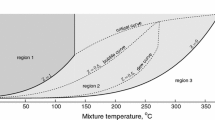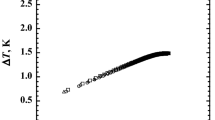Abstract
In power cycles using ammonia–water mixtures as the working fluid, several heat exchangers are used. The influence of different correlations for predicting thermophysical properties on the calculations of the size of the heat exchangers is presented. Different correlations for predicting both the thermodynamic and the transport properties are included. The use of different correlations for the thermodynamic properties gives a difference in the total heat exchanger area of 7%, but for individual heat exchangers, the difference is up to 24%. Different correlations for the mixture transport properties give differences in the predicted heat exchanger areas that are, at most, about 10% for the individual heat exchangers. The influence on the total heat exchanger area is not larger than 3%. A difference in the total heat exchanger area of 7% would probably correspond to less than 2% of the total cost for the process equipment. Experimental data and correlations developed for the ammonia–water mixture transport properties are very scarce. The evaporation and condensation processes involving ammonia–water mixtures are also not fully understood.
Similar content being viewed by others
REFERENCES
E. Thorin, C. Dejfors, and G. Svedberg, Int. J. Thermophys. 19:501 (1998).
E. Thorin, Int. J. Thermophys. 21:853(2000).
G. Pinevic, Kholodil. Tekh. 3:30 (1948).
M. J. Frank, J. A. Kuipers, and W. P. M. van Swaaij, J. Chem. Eng. Data 41:297 (1996).
L. Riedel, Chem. Ing. Tech. 3:59 (1951).
A. N. Baranov, B. R. Churagulov, A. I. Kalina, F. Y. Sharikov, A. A. Zharov, and A. B. Yaroslavtsev, in Report of the Workshop on Thermophysical Properties of Ammonia/Water Mixtures, NISTIR 5059, D. G. Friend and W. M. Haynes (NIST, Boulder, CO, 1997), pp. 59-67.
R. C. Reid, J. M. Prausnitz, and B. E. Poling, The Properties of Gases Liquids, 4th ed. (McGraw-Hill, New York, 1987).
S. S. Stecco and U. Desideri, in Proceedings of the ASME Cogen-Turbo, IGTI, Vol. 6 (ASME, New York, 1991), pp. 389-396.
U. Desideri, personal communication (Department of Industrial Engineering, University of Perugia, Perugia, Italy, 1994).
Y. M. El-Sayed, in Proceedings of ASME Winter Annual Meeting, Vol. I-11. (ASME, Chicago, 1988), pp. 19-24.
Y. M. El-Sayed, personal communication (Advanced Energy Systems Analysis, Fremont, CA, 2000).
N. M. Singh, Progr. Refrig. Sci. Technol. 2:473 (1973).
A. Luikov, A. Shashkov, and T. Abramenko, Proc. 4th Symp. Thermophys. Prop. (1968), pp. 411-415.
R. Tillner-Roth and D. Friend, J. Phys. Chem. Ref. Data 27:63 (1998).
S. S. Stecco and U. Desideri, ASME paper 89-GT-149 (1989).
B. Ziegler and Ch. Trepp, Int. J. Refrig. 7:101 (1984).
Y. M. El-Sayed and M. Tribus, ASME AES 1:89 (1985).
M. Hultén and T. Berntsson, Int. J. Refrig, 22:91, (1999).
Y. M. El-Sayed and M. Tribus, ASME AES 1:97 (1985).
W. M. Kays and A. L. London, Compact Heat Exchangers, 3rd ed. (Krieger, Malabar, FL, 1998).
G. F. Hewitt, Hemisphere Handbook of Heat Exchanger Design (Hemisphere, New York, 1990).
S. Kakac and H. Liu, Heat Exchangers-Selection, Rating and Thermal Design (CRC Press LLC, Boca Raton, FL, 1998).
A. Dvoiris and M. D. Mirolli, in Proc. 1998 ASME Fluids Eng. Div. Meet. Vol. 254 (Washington, DC, 1998), pp. 1-9.
P. Rohlin, Zeotropic Refrigerant Mixtures in Systems and in Flow Boiling, Doctoral thesis (Royal Institute of Technology, Stockholm, 1996).
A. Cohn, EPRI AP-4681, Project 2528-4, Final Report (1986).
A. I. Kalina, H. M. Leibowitz, D. W. Markus, and R. I. Pelletier, ASME paper 91-GT-365 (1991).
W. von Gajewski, A. Lezuo, R. Nürnberg, B. Rukes, and H. Vesper, VGB Kraftwerkstechnik 69:477 (1989).
Author information
Authors and Affiliations
Rights and permissions
About this article
Cite this article
Thorin, E. Thermophysical Properties of Ammonia–Water Mixtures for Prediction of Heat Transfer Areas in Power Cycles. International Journal of Thermophysics 22, 201–214 (2001). https://doi.org/10.1023/A:1006745100278
Issue Date:
DOI: https://doi.org/10.1023/A:1006745100278




